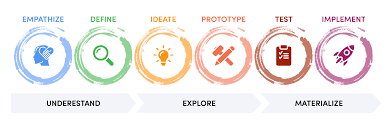The Power of Design Thinking Methodology
Design thinking is a problem-solving approach that has gained significant popularity in recent years due to its effectiveness in fostering innovation and creativity. This methodology, rooted in the designer’s mindset, offers a structured framework for tackling complex challenges and generating innovative solutions.
Understanding the Design Thinking Process
At its core, design thinking revolves around empathy, ideation, prototyping, and testing. The process begins by empathising with the end-users to gain a deep understanding of their needs, motivations, and pain points. This empathetic approach allows designers to uncover insights that may not be apparent at first glance.
Next comes the ideation phase, where diverse ideas are generated through brainstorming sessions and creative exercises. This phase encourages out-of-the-box thinking and promotes collaboration among team members to explore different perspectives and approaches.
Once ideas have been generated, the focus shifts to prototyping – creating tangible representations of potential solutions. Prototypes serve as low-cost experiments that allow designers to gather feedback early on and refine their concepts based on user input.
Finally, the testing phase involves putting prototypes in front of users to gather feedback and insights. This iterative process enables designers to validate their assumptions, identify areas for improvement, and refine their solutions before final implementation.
The Impact of Design Thinking
Design thinking methodology has proven to be a powerful tool for driving innovation across various industries. By placing human needs at the centre of problem-solving efforts, organisations can create products and services that resonate with their target audience.
Furthermore, design thinking encourages a culture of experimentation and continuous learning within teams. It empowers individuals to take calculated risks, embrace failure as a learning opportunity, and iterate on their ideas until they achieve success.
In Conclusion
In today’s fast-paced and ever-changing world, design thinking offers a structured yet flexible approach to problem-solving that can lead to breakthrough innovations. By embracing this methodology and cultivating a design-centric mindset within your organisation, you can unlock new possibilities and drive meaningful change that resonates with your audience.
“Understanding the Design Thinking Approach to Learning”
“Deciphering the Methodology of the Design Process”
4. “The Significance of Design Thinking Method
- What are the 5 stages of design thinking methodology?
- What is the design thinking method of learning?
- What is the methodology of design process?
- Why is design thinking methodology important?
What are the 5 stages of design thinking methodology?
Design thinking methodology encompasses five key stages that guide the problem-solving process towards innovative solutions. The first stage is Empathize, where designers immerse themselves in the users’ experiences to gain a deep understanding of their needs and challenges. This is followed by Define, where the problem is framed based on insights gathered during the empathy phase. The Ideate stage focuses on generating a wide range of creative ideas through brainstorming and collaboration. Next comes Prototype, where rough representations of potential solutions are created for testing and feedback. Finally, the Test stage involves putting prototypes in front of users to gather insights and refine the design based on real-world feedback. These five stages form a structured framework that empowers designers to address complex problems with empathy, creativity, and user-centricity at its core.
What is the design thinking method of learning?
The design thinking method of learning is a dynamic and innovative approach that emphasises problem-solving through a human-centred perspective. By integrating principles from the design world into the realm of education, this methodology encourages learners to empathise with end-users, ideate creative solutions, prototype tangible concepts, and test ideas through iterative feedback loops. Design thinking in learning environments fosters a collaborative and experimental mindset, empowering students to tackle complex challenges with creativity, empathy, and a bias towards action. This method not only equips learners with practical problem-solving skills but also cultivates a mindset of continuous improvement and innovation essential for navigating today’s rapidly evolving educational landscape.
What is the methodology of design process?
The methodology of the design process, particularly in the context of design thinking, encompasses a structured approach to problem-solving that prioritises empathy, ideation, prototyping, and testing. Designers begin by deeply empathising with end-users to understand their needs and challenges. This understanding informs the ideation phase where diverse ideas are generated through collaborative brainstorming sessions. Subsequently, prototypes are developed to visualise and test potential solutions before receiving feedback from users. This iterative process allows designers to refine their concepts based on real-world insights, ultimately leading to innovative and user-centric design solutions.
Why is design thinking methodology important?
Design thinking methodology is important because it provides a structured framework for problem-solving that prioritises empathy, creativity, and innovation. By focusing on understanding the needs and perspectives of end-users, design thinking helps to create solutions that are truly user-centric and address real-world challenges effectively. This approach encourages collaboration, experimentation, and iteration, allowing teams to explore diverse ideas and refine their concepts based on feedback. Ultimately, design thinking methodology empowers individuals and organisations to think outside the box, drive meaningful change, and stay ahead in today’s competitive landscape.
